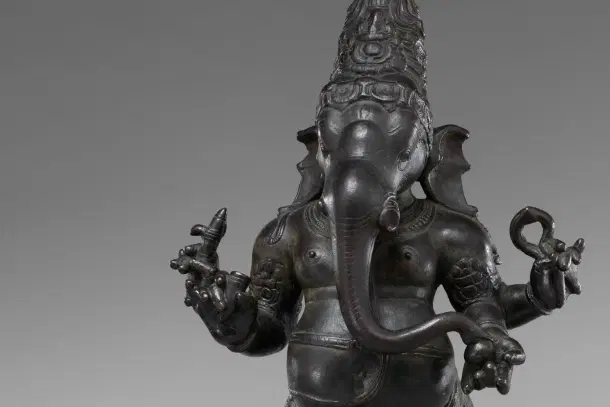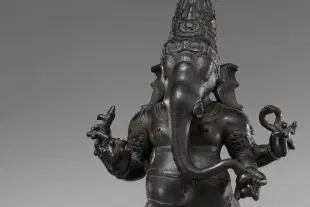Culture
The Agaval Revolution: When Esoteric Wisdom Became Everyone's Inheritance
Aravindan Neelakandan
Aug 27, 2025, 10:06 AM | Updated Aug 28, 2025, 03:16 PM IST
Save & read from anywhere!
Bookmark stories for easy access on any device or the Swarajya app.


In 1310, in a public square in Paris, the Christian mystic Marguerite Porete was burned at the stake. Her crime was writing and refusing to renounce her book, ‘The Mirror of the Simple Souls’, a treatise on the soul's direct union with God. The Church denounced her work as heretical, ordered all existing copies to be burned, and banned its circulation. For over 600 years, Porete and her profound text were driven into obscurity, only to be rediscovered in the 1940s as a subject of academic interest.
Three centuries earlier, in 10th century South India, another woman, the revered saint-poetess Avvaiyar, composed a spiritual treatise of equally profound and esoteric complexity and even more emphasising the relation between the seeker and the Divine over institutional religion: the Vinayagar Agaval. This 72-line poem maps the entire journey of consciousness, from devotional surrender to the highest states of Yogic and Tantric realisation.
Yet, instead of being condemned, Avvaiyar was celebrated and increases to this day in her veneration. Instead of being burned, her book was embraced, memorised, and transmitted through generations, becoming a cherished ‘People's Veda’.
This stark contrast—a mystic executed versus a mystic venerated (both women), a text suppressed versus a text popularised—is no historical accident. It reveals a fundamental divergence in civilisational approaches to divine wisdom. The suppression of Porete’s work is part of a broader pattern in many traditions where esoteric knowledge was either placed under strict institutional control or violently marginalised. This is seen in the historical gatekeeping of Jewish Kabbalah, which was restricted to mature male scholars , and the persecution faced by Sufi mystics at the hands of orthodox Islamic states and coopting them only for proselytising purposes.
The enduring legacy of Avvaiyar’s Agaval, however, illustrates a different path: a unique form of spiritual democracy. It shows a civilisation that created mechanisms not to restrict profound truths, but to make them accessible, weaving them into the very fabric of daily life. The Vinayagar Agaval is the master key to understanding how this was achieved.
The Heritage of Harmony
This spiritual democracy was made possible by a core Hindu philosophical principle: Samanvaya, or harmony. It is an approach that seeks to reconcile diverse teachings, revealing their single, unified purpose. Avvaiyar’s work was a brilliant continuation of this tradition, which had been masterfully articulated centuries earlier in Tirumular's Thirumanthiram.
This monumental text was a highly technical blueprint synthesising the Vedic, Yogic, and Agamic paths. Avvaiyar’s genius was to distil this vast, complex wisdom of 3000 verses into a short, lyrical, and potent handbook of 72 lines for every devotee.
This distillation is powered by a central concept: Arul. Often translated as ‘grace’, this term is better understood in its native context. It is not a passive blessing but an active, dynamic, and feminine divine energy—‘a Shakti active and female aspect of Siva.’ In Avvaiyar’s poem, the entire spiritual journey is initiated, sustained, and brought to fruition by the overwhelming compassionate energy of Ganesa’s Arul. This reframes the spiritual path from one of arduous human striving to one of divine partnership.
The Integrated Path: A Journey Within
The Agaval presents a direct, experiential testimony of this Arul-driven transformation. The journey begins when the seeker’s own efforts fail and they beseech the Divine for intervention. Ganesha’s response is profoundly intimate. First, he appears as a Mother, providing unconditional, nurturing love and severing the metaphysical cord that binds the soul to the worldly cycle (samsara).
Having established this foundation of love, Ganesha then assumes the role of the Guru. Through formal initiation, He begins the esoteric work: removing the bonds of Karma with His tusk, whispering wisdom of ultimate clarity into the seeker's ear, and revealing the inner cartography of the subtle body. Avvaiyar details a sophisticated Yogic and Tantric process guided by Ganesha: the control of the five senses, the stilling of inner faculties, the awakening of Kundalini (the sleeping serpent energy), and its ascent through the six vital centres (adharas). This guided journey demonstrates the seamless integration of Bhakti (devotion), Yoga (discipline), and Tantra (esoteric methodology) into a single, cohesive practice.
The Pinnacle of Synthesis: Advaita Bhakti
Perhaps the poem’s most profound achievement is its reconciliation of what appear to be contradictory philosophical schools: the qualified non-dualism of Saiva Siddhanta and the absolute non-dualism of Advaita Vedanta. The poem’s structure mirrors this spiritual integration. It begins with a tangible, relatable description of Ganesha’s form (Saguna)—from his ‘lotus feet’ to his ‘elephant face’—grounding the devotee in a personal divine image. It then transitions into the abstract, formless (Nirguna) experience of deep meditation, where the mind dissolves into a state ‘beyond words’.
Crucially, the journey does not end in this formless abstraction. The liberated state is not a permanent dissolution that negates the relationship with the Deity. Instead, the devotee returns to worship the very same ‘fragrant, heroic feet’ of Ganesha, but now with a transformed vision, seeing the Absolute embodied in the form. This cyclical journey embodies the principle of Advaita Bhakti: the realisation of the formless Absolute deepens and enriches the devotee’s love for the personal Divine.
The Resilient Tradition and Its Modern Challenge
Avvaiyar achieved this spiritual democracy through a brilliant synergy of text and iconography. She chose Ganesha (known affectionately as Pillaiyar, the ‘Noble Child’), the most visible and approachable Deity, as her focus. This created a decentralised spiritual academy operating on two tracks:
The Aural Curriculum: The Vinayagar Agaval itself, composed in a simple, rhythmic meter that is easily memorised and passed down orally within families.
The Non-Localised Visual Icon as Classroom: The all permeating public presence of Ganesa’s image (Murti)—on street corners, under ancient trees, and in home altars—making every icon a potential site for contemplation and a physical anchor for the poem’s teachings.
This distributed, non-hierarchical model makes the tradition incredibly resilient to external attack. One cannot eradicate a tradition that lives in countless homes and is woven into the very fabric of daily life. However, what cannot be destroyed by external force can be eroded by internal neglect. Today, this popular treasure faces a challenge as fewer members of the younger generations know this hymn by heart.





